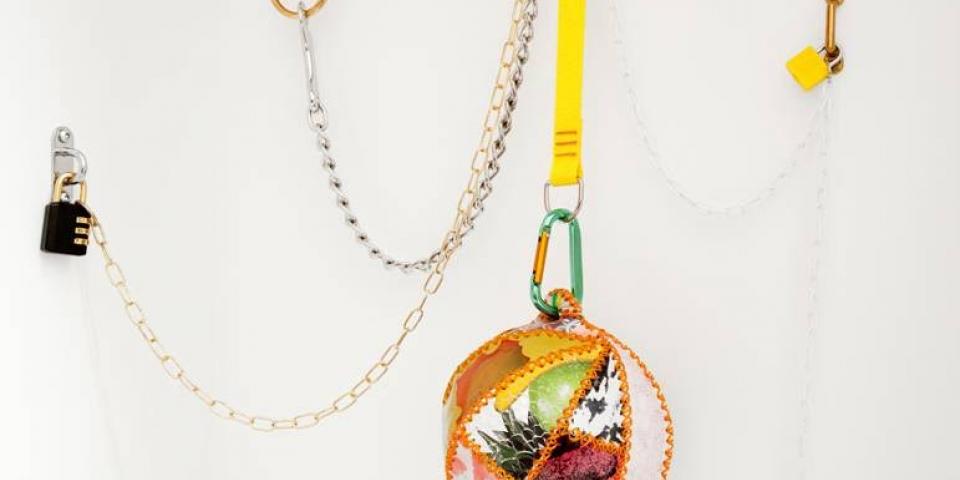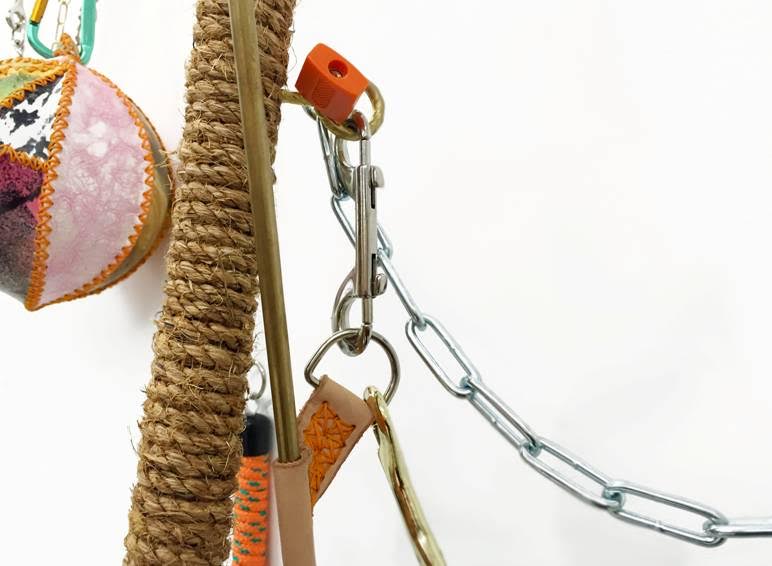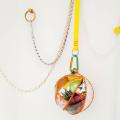
Rattle Clank Jingle Keys Locked #2
A tool shed filled with hunting and sport equipment? An intimate chamber filled with fetish and torture tools? Or an aesthetic display of luxurious design products?
Recognizable everyday objects and tools, shiny gold chains, colorful cords and patchwork of leather and patterned cloth form an unusual composition that meets the viewer’s gaze in an outdoor display box in a narrow path in Roskilde. The objects insist on and call for physical interaction and performance. But who holds the key for this tool shed? And which rituals will the tools be part of?
 (Detail: Maiken Bent, Rattle Clank Jingle Keys Locked #2, 2015)
(Detail: Maiken Bent, Rattle Clank Jingle Keys Locked #2, 2015)
The work Rattle Clank Jingle Keys Locked #2 plays with contradictions and tensions: the exquisite materials, gentle stitching and light colors contrast with the shiny, hard steel and the padlocks. The composition of iron chains, whips and padlocks connotes dominance, captivity and fixed bodies and states – or maybe the key to free, unrestrained physical play.
In the art practice of Maiken Bent tensions and paradoxes are underlying themes. In her works traditional contradictions are put together and mixed; the feminine and the masculine, readymade and crafts, the tactile and the smooth, pain and pleasure, aesthetics and fetish, rationality and functionality.
Conditions concerning gender and body are also central to the works of Bent, where multiple transformations take place. Masculine (survival) tools are transformed into feminine, aesthetic design products connected to our fetish, fitness and consumer culture. The tools are given new functions, like the body, that becomes the subject for new kinds of performances. Bent presents to us a versatile fetishised universe, where the line between pleasure and pain is dissolved in an aestheticization of kinky BDSM-apparatuses and kitschy Gucci bling. But the playful expression carries a grave undertone of a used, punished or tortured body. The more or less abstract composition of the objects produces no final answers, but suggests a range of possible scenarios.
When it comes to the artistic traditions and traces in the art practice of Bent here too is a play with contradictions and tensions. Bent is inscribed in a long battle of/with/against representation forms, decoration and figurations in art. With her unusual compositions and patterns Bent draws on the early 20th century’s tradition of abstract painting. But while this tradition strove to eliminate the human presence, Bent is working with the human body as a central component in her art. She uses readymade objects as both abstract and figurative elements that creates a number of imageries and performs versatile statements.
Through an aesthetic and sensual play we are lured closer. The narrative and the body that are absent in the works the viewer can fantasize about. In this way we take part of a game, where the seductive and the repulsive coexist.
